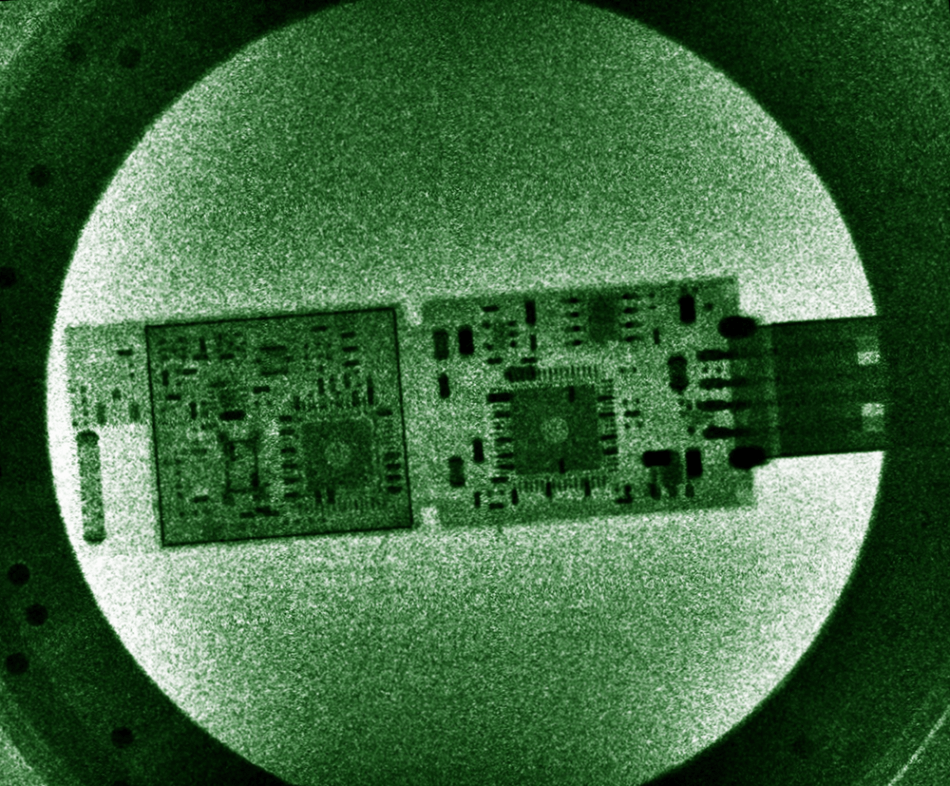Jun 27 2017
Physicists from the University of Nebraska-Lincoln are now observing a daily phenomenon in a new light.
 Using a laser focused to the brightest intensity yet recorded, Physicists at the Extreme Light Laboratory produced unique X-ray pulses with greater energy than their conventional counterparts. The team demonstrated these X-rays by imaging the circuitry of a USB drive. Credit: Extreme Light Laboratory | University of Nebraska-Lincoln
Using a laser focused to the brightest intensity yet recorded, Physicists at the Extreme Light Laboratory produced unique X-ray pulses with greater energy than their conventional counterparts. The team demonstrated these X-rays by imaging the circuitry of a USB drive. Credit: Extreme Light Laboratory | University of Nebraska-Lincoln
These Physicists have seen changes in a vision-enabling interaction between light and matter by focusing laser light to a brightness 1 billion times greater than the surface of the sun, the brightest light that has ever been produced on Earth.
Those changes produced exclusive X-ray pulses capable of generating exceptionally high-resolution imagery useful for security, scientific, engineering and medical purposes. The findings have been published in the June 26th issue of the journal Nature Photonics, and these findings should help in informing future experiments dealing with high-intensity lasers.
Donald Umstadter and colleagues at the University’s Extreme Light Laboratory fired the Diocles Laser at helium-suspended electrons in order to measure how the laser’s photons scattered from a single electron after striking it. The laser’s photons are considered to be both particles and waves of light.
That scattering phenomenon allows vision to be possible under typical conditions when light from the sun or a bulb strikes a surface. However, an electron, referring to the negatively charged particle existing in matter-forming atoms, generally scatters just one photon of light at a time. Umstadter stated that the average electron very rarely enjoys even that privilege as it gets struck only once every four months or so.
Umstadter’s team succeeded in scattering almost 1,000 photons at a time even though earlier laser-based experiments had scattered a few photons from the same electron. Both the electron and the photons behaved in a much different manner than usual at the ultra-high intensities produced by the laser.
When we have this unimaginably bright light, it turns out that the scattering — this fundamental thing that makes everything visible — fundamentally changes in nature.
Donald Umstadter, the Leland and Dorothy Olson Professor of Physics and Astronomy
A photon from standard light will normally scatter at the same angle and energy it featured prior to striking the electron, despite how bright its light could be. Yet Umstadter’s team discovered that, above a specific threshold, the laser’s brightness adjusted the wavelength, shape and angle of that scattered light.
“So it’s as if things appear differently as you turn up the brightness of the light, which is not something you normally would experience,” Umstadter said. “(An object) normally becomes brighter, but otherwise, it looks just like it did with a lower light level. But here, the light is changing (the object’s) appearance. The light’s coming off at different angles, with different colors, depending on how bright it is.”
That phenomenon partly took place from a change in the electron, which discarded its standard up-and-down motion in favor of a figure-8 flight pattern. The electron, like in normal conditions, ejected its own photon, which was jarred loose by the energy from the incoming photons. However, the Researchers discovered that the ejected photon absorbed the energy collected from all the scattered photons, granting it the wavelength and energy of an X-ray.
Umstadter highlighted the possibility of using the unique properties of that X-ray in multiple ways. Its extreme but narrow energy range, incorporated with its exceptional duration, could help produce three-dimensional images on the nanoscopic scale while decreasing the dose required for producing them.
Those qualities could qualify it to hunt for microfractures or tumors that elude standard X-rays, detect greatly sophisticated threats at security checkpoints, or map the molecular landscapes of nanoscopic materials currently finding their way into semiconductor technology. Molecular and Atomic Physicists could also use the X-ray as a form of ultrafast camera for capturing snapshots of chemical reactions or electron motion.
Umstadter and his colleagues, who are Physicists themselves, also expressed their enthusiasm for the scientific implications of their experiment. The Researchers confirmed a recently projected method for measuring a laser’s peak intensity by establishing a relationship between the brightness of the laser and the properties of the laser’s scattered light. The study also supported many longstanding hypotheses that technological restrictions had prevented Physicists from directly testing.
There were many theories, for many years, that had never been tested in the lab, because we never had a bright-enough light source to actually do the experiment. There were various predictions for what would happen, and we have confirmed some of those predictions. It’s all part of what we call electrodynamics. There are textbooks on classical electrodynamics that all physicists learn. So this, in a sense, was really a textbook experiment.
Donald Umstadter, the Leland and Dorothy Olson Professor of Physics and Astronomy
The study was Authored by Umstadter with Sudeep Banerjee and Shouyuan Chen, Research Associate Professors of Physics and Astronomy; Grigory Golovin and Cheng Liu, Senior Research Associates in Physics and Astronomy; Wenchao Yan, Ping Zhang, Baozhen Zhao and Jun Zhang, Postdoctoral Researchers in Physics and Astronomy; Colton Fruhling and Daniel Haden, Doctoral Students in Physics and Astronomy; along with Min Chen and Ji Luo of Shanghai Jiao Tong University.
The Air Force Office for Scientific Research, the National Science Foundation, the U.S. Department of Energy’s Office of Science, the Department of Homeland Security’s Domestic Nuclear Detection Office and the National Science Foundation of China supported the team.